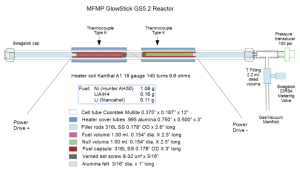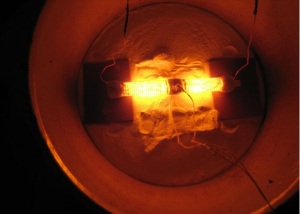The ‘open science’ group, Martin Fleischmann Memorial Project, MFMP, that I mention at the end of my book An Impossible Invention, has announced that they have performed a true replication of the effect in Rossi’s energy device, the E-Cat. The group has also published a complete recipe of how to replicate the effect, adding a clear method for detecting a successful replication.
Update: Here’s a video from MFMP discussing the result.
In a letter to donors, MFMP’s writes:
“What we will share is that the way in which we discovered it and the journey of analysis (…) makes it virtually impossible to say that Rossi does not have what he claims. It also shows that, whilst he may have been optimistic in how fast this would play out, he has been telling the truth, quite openly for years. Not only that, nature itself has been telling the same story and it told us too.”
Bob Greenyer, co-founder of the group, explained to me that the successful replication was based on all available information MFMP had got from from experienced LENR researchers Francesco Piantelli and Francesco Celani, and from the Russian scientist Alexander Parkhomov who also claims to have replicated Rossi’s effect, as well as openly shared information by Andrea Rossi himself.
The main evidence for the effect in MFMP’s experiment is a combination of ‘excess heat’—i.e. thermal energy released from the reaction, beyond the input energy—and x-ray radiation—i.e. the same kind of low energy radiation used in medical radiography. Important is that the x-ray emissions were observed only together with excess heat.
The character of the x-ray signal is, according to MFMP, the best way to detect that the replication is successful. The energy of the x-ray photons are between 0 and 300 keV (medical radiography typically uses x-rays between 5 and 150 keV), and there’s a brief but massive burst of x-rays when the reaction starts. This was observed also at the first semi-public demonstration of the E-Cat by Rossi in January 2011.
The heat from Rossi’s devices supposedly comes directly from the reaction and from the low energy x-rays which are thermalised—turned into harmless heat—by shielding materials such as lead.
The experiments by MFMP have been performed during the last three weeks, with a duration of about 20 hours of excess heat/x-rays on February 1-2. Everything is publicly documented at MFMP’s website Quantumheat.org, also the recipe, which essentially explains how to prepare the fuel consisting of nickel, lithium, hydrogen and aluminium, and how to run the experiment.
The preparation is fairly complicated and probably requires significant practice to master. It must be underlined that attempts should only be undertaken by trained people and with all necessary safety measures in place.
MFMP now plans to do follow-up experiments with the isotope Ni62 (an isotope is a special variety of any element, with the number indicating the number of nucleons in the atomic nucleus) which might enhance the effect.
In the following months, we should also expect an increased activity of replication attempts all over the world, possibly leading to a broad confirmation of the effect in Rossi’s E-Cat. On the other hand, it can be noted that Rossi had this knowledge already some five or six years ago, and reasonably has been able to further develop the process since.
I would like to take this opportunity to congratulate MFMP for its achievement, as a result of intense efforts, supported by a large group of donors and people offering their advice. As MFMP ends the letter to the donors:
“We did it. We lit the New Fire Together!”
§
Here’s the complete letter to the donors from MFMP:
Dear Donor,
During ICCF-17 in South Korea, shortly following the sad death of Dr. Martin Fleischmann, it became abundantly clear to a group of fresh attendees that the old approach to science, combined with the ostracisation of the great minds that had worked in the face of ridicule, was not delivering on the promise of of what we immediately called, “The New Fire”.
It also was clear that there was something to investigate and we were morally bound to do it.
We said that people would not believe, until they could experience it as if they were doing themselves and so the idea of Live Open Science was born. That was not enough, it had to be an effort that was free from commercial or government interests and that result and so it had to be conducted by the people, for the people. Our journey was made possible by the courage of Francesco Celani and we thank him profusely.
Your donations played a critical role in realising this vision, but you know that, what we know you will want to hear is what we have to share tomorrow.
We have been running and analysing an experiment live over the past Month. First for us in this experiment were:
– Parkhomov Baking of Ni(correctly done)
– Pre Hydrogenation of Ni
– Proper baking out of cell under vacuum
– Parkhomov pressure
– Piantelli de-oxygenation
– Piantelli ‘loading’ + proper dwell times
– Piantelli capture analogue
– Use of free Lithium
– Use of calibrated NaI
– Cycles attempting to create nano Ni distillates (inspired by “Bang!” discovery of dissolved Ni)
– Long Run
You can see that there are steps in there that came about only because of activities that were made possible by donations. The critical visits to Piantelli and Parkhomov.
Around the beginning of the month we saw what appeared to be up to a COP of 1.2, not earth shattering, but sustained and robust and in line with both observations by others and the Lugano report when adjusted for correct emissivity. Over the next weeks we tried various bookend calibrations which supported this finding.
We have said that only two paths would satisfy us:
Statistically significant Isotopic or elemental shifts from Fuel to Ash
Statistically significant emissions commensurate, correlating, or anti correlating to excess heat
We are happy to tell you that we believe we have satisfied our condition 2, yet of course we’d like to replicate ourselves. Actually, though, it goes much further than that. What we will share is that the way in which we discovered it and the journey of analysis that makes it virtually impossible to say that Rossi does not have what he claims. It also shows that, whilst he may have been optimistic in how fast this would play out, he has been telling the truth, quite openly for years. Not only that, nature itself has been telling the same story and it told us too.
By the 16/02/2016 we had given up trying to destroy the *GlowStick* 5.2, part of a long lineage of []=Project Dog Bone=[] experiments. After the reactor was turned off, Alan shared the remainder of the data files from the NaI scintillator kindly donated by a project follower called Stephen (Thankyou Stephen, really).
Project follower and open science legend, Ecco, first took a look at the data and found some anomalies – one SO striking that we thought there had been an equipment failure. We did not know the time that the anomalies occurred and had to wait until Alan woke to explain the time stamps so we could correlate it with the thermal and power data published live to HUGNet (Thankyou Ryan and Paul Hunt).
To our extreme surprise, the onset of excess heat followed the massive anomaly in emissions and the minor anomalies were during and only during excess heat.
This led us on a path of discovery, the sequence of which explains:
The massive count signal discovered by Francesco Celani during Rossi’s first public demo
How Rossi knew his reactor had started
How the E-Cat generates excess heat
How it self sustains
How it can scale easily
That it is safe
It also showed us how replicators can know they have succeeded in triggering the New Fire and how to enhance the excess heat.
Subsequent to this, we found out Rossi had travelled the same design journey and had publicly shared it in the past.
The irony is – this was all being conducted live in the open, including discussions and graphing, whilst people were distracted with news of the end of the 1MW 1 year test. Same day…
In the past week we have been checking, cross checking to verify and this morning we cleared our last serious doubt, again live, with shared data. Because this is already in the open we want people to know so that they can start replicating based on what works, moreover, the insight will allow people to immediately start improving on our results.
Thank you for making this possible
We did it
We lit the New Fire Together!
§
And here’s the recipe in short form, as published by MFMP on February 24, 2016. For further details, please visit Quantumheat.org:
Prepare thoroughly (Ni + LiAlH4 + Li)
1. Bake Ni
2. Reduce Ni
3. Hydrogenate Ni
4. Mix: Ni + LiAlH4 + Li
5. Bake and vac reactor, add Mix, vac warm, add H2, Vac
6. Heat to above Mössbauer determined Ni Debye (say 135C), pressure regulated to approx 1bar abs.
7. Hold, pressure regulated to approx 1bar abs.
8. Heat slowly to as close to Ni Curie as comfortable (Say 340C), pressure regulated to approx 1bar abs.
9. Hold, pressure regulated to approx 1bar abs.
10. Slowly lower temp to above highest known Ni Debye (Say 220C), pressure regulated to approx 1bar abs.
11. Hold, pressure regulated to approx 1bar abs.
12. Go as fast as possible through Ni Curie
13. Hold, pressure regulated to approx 0.5bar abs.
14. Cycle through 500C internal, pressure regulated to approx 0.5bar abs.
15. Hold, pressure regulated to approx 0.5bar abs.
16. Raise internal temperature to over 1200, pressure regulated to approx 0.5bar abs.
17. Drop to around 1000C and hold, pressure regulated to approx 0.5bar abs.
18. Raise internal temperature to near boiling point of Lithium
Some of the above steps may in time be redundant.
1h Thermal > x/β- (0-100KeV) emissions thermalised in Lead > IR/THz (via blackbody) > 5h (SSM)
where ‘>’ means ‘leads to’


